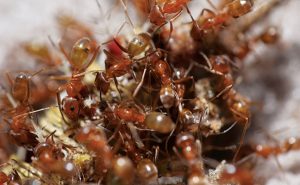
Pyramid ants are predators, and have been known to keep fire ant populations at bay.
Photo courtesy of, and copyrighted by, Gene White, pmimages@earthlink.net
Q: In a city park about the size of 10 football fields, pyramid ants (Dorymyrmex spp.) are on every square inch of the park. I can’t keep the ants out of the grounds around a water park where parents sit at picnic tables. Ants are all over people’s feet and no one is happy. What’s your best treatment for pyramid ants?
—Kim B., Florida
A: Pyramid ants only have about 1,000 workers per colony. They prefer sweets. Control usually is accomplished by injecting a residual into each nest using a hand-compressed air sprayer and a nozzle with an injection tip. That is going to be a big task if you have hundreds or thousands of colonies, but you could just concentrate on areas of concern, such as the picnic area.
Broadcast granular baits are not sweet, so they won’t work well. I would stick with treating individual colonies by injecting a non-repellent insecticide into each colony.
Q: Yellowjackets have been entering a house around a skylight. In the late fall, yellowjacket activity ceased, but now carpet beetles are being found in the area. Do you think there is a nest in the roof? Should it be removed now? What can I do about the carpet beetles? Do yellowjackets change their diet during the summer — and if so, why?
— Bill C., Wisconsin
A: Yellowjackets do change their diet during the summer. In spring and early summer, the adults are collecting proteins (other insects, mostly) to feed the larvae. When the queen stops laying eggs in mid-summer, there are no larvae and the adults begin foraging for sugars — which is why they show up at picnics and other outdoor events that have soda and beer available.
The original queen dies and workers begin to die off. New queens emerge, seeking overwintering sites such as under bark and in attics, for example. The old nest is usually vacant, so now is the time to remove it.
A yellowjacket nest probably is in the roof and they entered around the skylight coping. The carpet beetles probably are feeding on old larval and pupal skins and old paper cells. You should remove the old nest.
You might need to coordinate with a roofer who can open the roof and then properly reseal it after the nest is removed. You should apply a good residual spray in the nest area to kill off any stray carpet beetles or their larvae.
Q: I live in a rural area, and every year mice migrate into the homes of my customers. I’ve been reading about many of the new repellents and wonder whether they would help me. Should I apply them after or before the mice have entered?
— Mike G., Wyoming
A: Repellents for rodents only work well if the rodents haven’t established a path between A and B (food and nest, etc.). A rodent wandering about seeking food or a nest site will be deterred by a good repellent. A rodent that knows food is available on the other side of the barrier might not be repelled because the attraction of the food is stronger than the repellent.
A good plan would to be to apply the repellent before the mice begin to migrate. Once they are inside, a repellent won’t help you much. Depending on the repellent, you might need to reapply during the migration season.
Email your questions about insect identification and pest management technologies and techniques to Dr. Mampe at dentomol@aol.com. Your questions most likely will be printed and answered in one of Pest Management Professional’s upcoming Ask the Expert columns.
Leave A Comment